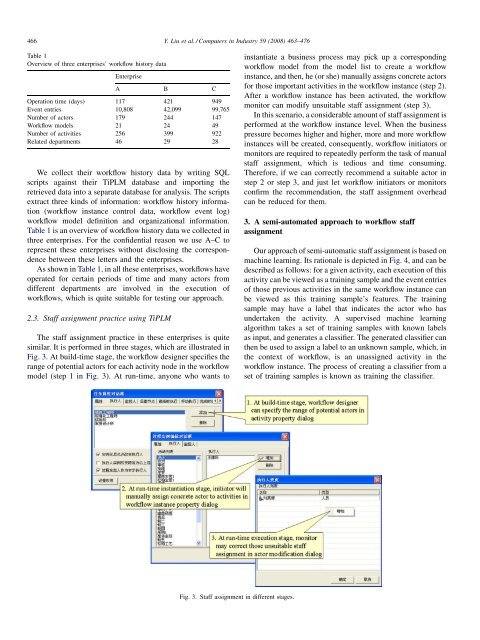A semi-automatic approach for workflow staff assignment - Faculty of ...
A semi-automatic approach for workflow staff assignment - Faculty of ...
A semi-automatic approach for workflow staff assignment - Faculty of ...
Create successful ePaper yourself
Turn your PDF publications into a flip-book with our unique Google optimized e-Paper software.
466<br />
Y. Liu et al. / Computers in Industry 59 (2008) 463–476<br />
Table 1<br />
Overview <strong>of</strong> three enterprises’ <strong>workflow</strong> history data<br />
Enterprise<br />
A B C<br />
Operation time (days) 117 421 949<br />
Event entries 10,808 42,099 99,765<br />
Number <strong>of</strong> actors 179 244 147<br />
Workflow models 21 24 49<br />
Number <strong>of</strong> activities 256 399 922<br />
Related departments 46 29 28<br />
We collect their <strong>workflow</strong> history data by writing SQL<br />
scripts against their TiPLM database and importing the<br />
retrieved data into a separate database <strong>for</strong> analysis. The scripts<br />
extract three kinds <strong>of</strong> in<strong>for</strong>mation: <strong>workflow</strong> history in<strong>for</strong>mation<br />
(<strong>workflow</strong> instance control data, <strong>workflow</strong> event log)<br />
<strong>workflow</strong> model definition and organizational in<strong>for</strong>mation.<br />
Table 1 is an overview <strong>of</strong> <strong>workflow</strong> history data we collected in<br />
three enterprises. For the confidential reason we use A–C to<br />
represent these enterprises without disclosing the correspondence<br />
between these letters and the enterprises.<br />
As shown in Table 1, in all these enterprises, <strong>workflow</strong>s have<br />
operated <strong>for</strong> certain periods <strong>of</strong> time and many actors from<br />
different departments are involved in the execution <strong>of</strong><br />
<strong>workflow</strong>s, which is quite suitable <strong>for</strong> testing our <strong>approach</strong>.<br />
2.3. Staff <strong>assignment</strong> practice using TiPLM<br />
The <strong>staff</strong> <strong>assignment</strong> practice in these enterprises is quite<br />
similar. It is per<strong>for</strong>med in three stages, which are illustrated in<br />
Fig. 3. At build-time stage, the <strong>workflow</strong> designer specifies the<br />
range <strong>of</strong> potential actors <strong>for</strong> each activity node in the <strong>workflow</strong><br />
model (step 1 in Fig. 3). At run-time, anyone who wants to<br />
instantiate a business process may pick up a corresponding<br />
<strong>workflow</strong> model from the model list to create a <strong>workflow</strong><br />
instance, and then, he (or she) manually assigns concrete actors<br />
<strong>for</strong> those important activities in the <strong>workflow</strong> instance (step 2).<br />
After a <strong>workflow</strong> instance has been activated, the <strong>workflow</strong><br />
monitor can modify unsuitable <strong>staff</strong> <strong>assignment</strong> (step 3).<br />
In this scenario, a considerable amount <strong>of</strong> <strong>staff</strong> <strong>assignment</strong> is<br />
per<strong>for</strong>med at the <strong>workflow</strong> instance level. When the business<br />
pressure becomes higher and higher, more and more <strong>workflow</strong><br />
instances will be created, consequently, <strong>workflow</strong> initiators or<br />
monitors are required to repeatedly per<strong>for</strong>m the task <strong>of</strong> manual<br />
<strong>staff</strong> <strong>assignment</strong>, which is tedious and time consuming.<br />
There<strong>for</strong>e, if we can correctly recommend a suitable actor in<br />
step 2 or step 3, and just let <strong>workflow</strong> initiators or monitors<br />
confirm the recommendation, the <strong>staff</strong> <strong>assignment</strong> overhead<br />
can be reduced <strong>for</strong> them.<br />
3. A <strong>semi</strong>-automated <strong>approach</strong> to <strong>workflow</strong> <strong>staff</strong><br />
<strong>assignment</strong><br />
Our <strong>approach</strong> <strong>of</strong> <strong>semi</strong>-<strong>automatic</strong> <strong>staff</strong> <strong>assignment</strong> is based on<br />
machine learning. Its rationale is depicted in Fig. 4, and can be<br />
described as follows: <strong>for</strong> a given activity, each execution <strong>of</strong> this<br />
activity can be viewed as a training sample and the event entries<br />
<strong>of</strong> those previous activities in the same <strong>workflow</strong> instance can<br />
be viewed as this training sample’s features. The training<br />
sample may have a label that indicates the actor who has<br />
undertaken the activity. A supervised machine learning<br />
algorithm takes a set <strong>of</strong> training samples with known labels<br />
as input, and generates a classifier. The generated classifier can<br />
then be used to assign a label to an unknown sample, which, in<br />
the context <strong>of</strong> <strong>workflow</strong>, is an unassigned activity in the<br />
<strong>workflow</strong> instance. The process <strong>of</strong> creating a classifier from a<br />
set <strong>of</strong> training samples is known as training the classifier.<br />
Fig. 3. Staff <strong>assignment</strong> in different stages.
















